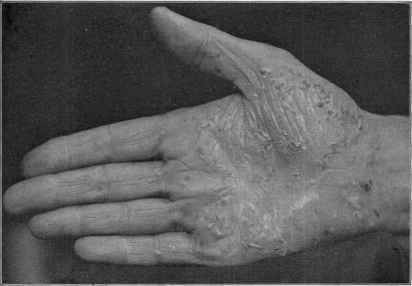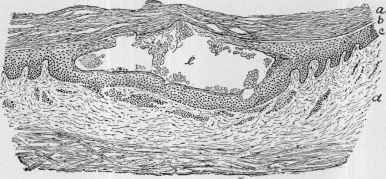| MEDICAL INTRO |
| BOOKS ON OLD MEDICAL TREATMENTS AND REMEDIES |
THE PRACTICAL |
ALCOHOL AND THE HUMAN BODY In fact alcohol was known to be a poison, and considered quite dangerous. Something modern medicine now agrees with. This was known circa 1907. A very impressive scientific book on the subject. |
DISEASES OF THE SKIN is a massive book on skin diseases from 1914. Don't be feint hearted though, it's loaded with photos that I found disturbing. |
POMPHOLYX
Synonyms.—Cheiropompholyx (Hutchinson); Dysidrosis (Tilbury Fox); Fr.,
Dysidrose.
Definition.—A rare acute inflammatory affection of vesicular
and bullous character, limited to the hands and feet, more especially
the palmar and plantar aspects.1
Symptoms.—The most common sites of the disease are the palms
and lateral surfaces of the fingers, occasionally extending on to the
dorsal surface. Not infrequently the soles of the feet are involved
also. Exceptionally it may be limited to the latter region. It is gen
erally symmetric. The eruption is usually foreshadowed by slight
burning of the part; soon small, somewhat deep-seated vesicles are seen,
usually close together, which enlarge, and which in appearance may often
be readily likened to boiled sago grains. The parts are reddened, and
sometimes swollen. The lesions vary somewhat in size between a pin-
head and a large bean. As a rule, new vesicles continue to arise for
several days or a few weeks, some of the older small ones becoming
milky and disappearing by absorption; or some becoming larger, the
contents milky and later purulent. When closely crowded, the result is
1 Principal literature: Tilbury Fox, Amer. Jour, of Syph. and Derm., 1873, vol. iv,
p. 1; Hutchinson, Illustrations of Clinical Surgery, 1876, vol. i, p. 49; Robinson, Arch.
Derm., 1877, p. 289; Fox and Crocker, Trans. London Patholog. Soc'y, 1878, vol. xxix,
p. 264; Hoggan (G. and F. E.), Monatshefte, 1883, pp. no and 148, with full bibliog
raphy to date; Unna, Histopathologie, p. 176 (based chiefly upon the investigations by
Williams and by Santi in Unna‘s laboratory); Williams, Brit. Jour. Derm., 1891, p. 303;
Santi, Monatshefte, 1892, vol. xv, p. 93 (with references).
POMPHOL YX
36l
coalescence, and the formation of large flat blebs or an undermining of the
upper skin with serous exudation. The smaller lesions show little if any
tendency to spontaneous rupture; the larger blebs are usually accidentally
broken, discharge their contents, and disclose the reddened corium or
lower rete layer, with no underlying thickening. Gradually the process
declines and complete recovery ensues, generally in the course of a few
weeks to a few months. All grades of the disease are met with, from that
in which the lesions are somewhat scanty, superficial, or deep-seated, to
that in which not only the entire palmar aspect of the hands is involved,
but a great part of the dorsal surface as well, together with the soles of
the feet.
In some instances the eruption will present on one or both the palms
but several pin-head to pea-sized lesions, which enlarge slightly, two

Fig. 86.—Pompholyx in an adult of forty, of a few weeks’ duration; recurrent.
or three may become confluent, the contents of all in the course of a few
days becoming purulent; there is a slight inflammatory areola surround
ing the lesions, one or two may be absorbed, or they are broken, especially
the larger ones, and the covering exfoliates, the skin soon regaining its
normal condition. An abortive type is sometimes observed on the
lateral aspects of the fingers.
The subjective symptoms are usually burning and a feeling of ten
sion; itching is rarely a marked feature. There is no constitutional
disturbance, although the patient‘s health, especially in the extensive
cases, is noted to be below the normal.
Etiology and Pathology.—The disease is most common in
those between advanced adolescence and middle age; it is scarcely
seen in children, and not often in old age. It is a somewhat rare dis-
362 INFLAMMATIONS
ease. It is observed, as a rule, in those whose health is below par,
and especially in those lacking nervous strength. In such patients,
after one attack, every decided departure from the normal standard,
through worry, fatigue, or exhaustion, is apt to be followed by an out
break, slight or severe in character. It has been noted in many of
the patients that the feet and hands sweat freely. It is much more
frequent in women.
The tendency of the lesions to group and its usually symmetric
character, and its occurrence in neurotic subjects, would properly lead
to the belief that the disease is a neurosis. Unna states that he has
constantly found in the vesicle sections made in his laboratory by Santi
and Williams a bacillus, resembling the tubercle bacillus, but thicker,
which he considers the essential pathogenic factor.

Fig. 87.—Pompholyx, showing vesicle (e) formed in the upper two thirds of the rete
(c), breaking through the stratum lucidum (b), with the covering corneous layer (a),
between the strata of which are seen lacunae caused by escaped sweat or from transuda-
tion from the papillæ. The vesicle contains at first clear serum, from the underlying
papillary blood-vessels, which later, from the invasion of leukocytes, becomes opaque.
The papillæ are slightly edematous, and the upper part of the corium (d) shows slight
inflammatory changes with perivascular cell-infiltration (courtesy of Dr. A. R. Robin
son).
Its supposed connection with the sweat-gland gave the name of
dysidrosis (Tilbury Fox, Crocker), but later and confirmed investiga
tions (Robinson, Hutchinson, Thin, Unna, Williams, and Santi) show
no special association with these structures, but indicate that it is an
inflammatory disease in which the lesions take their origin in the rete,
the fluid, which is at first pure serum, coming from the papillary blood-
vessels, and collecting between the rete cells.1 The effusion gives rise
to degeneration of some of these cells, and the others are gradually
pushed asunder to give room for the fluid collection. The upper cells
may rupture, and some serum also escape into the corneous layers.
The lesions later become purulent from the addition of pus-corpus-
cles, and contain some fibrin and a large amount of albumin; the con-
1 Nestorowsky (Dermatolog. Zeitsch., March, 1906, et seq.—abstract in Jour. Cutan.
Dis., 1906, p. 491), from histologic examination of many specimens, calls this in ques
tion—he considers it a disease of the sweat-glands and the vesicles as closely con
nected with their ducts.
POMPHOL YX
363
tents are never acid. They never contain sweat. The inflammatory
changes, are slight.
Diagnosis.—The beginning deep-seated lesions, their increase
in size, and usually in number, some coalescing and forming blebs,
and gradually becoming purulent, together with the localization of the
eruption, make a pretty clear picture of the malady, and usually render
the diagnosis a matter of no difficulty. It is to be distinguished from
acute eczema, which, however, it can scarcely be said to resemble greatly;
but in this latter disease the lesions are small, are markedly acute, in
great numbers, crowded together, with usually considerable inflamma
tory action and some infiltration; tend to rupture spontaneously, and
leave the characteristic oozing surface of eczema; the dorsal surfaces of
the hands and fingers are also, as a rule, involved, whereas in pompholyx
these parts are rarely affected to a great extent, and frequently not at all.
There are, however, mild cases of both disorders, the slight type of pom-
pholyx, with small and scanty lesions, and subacute eczema of limited
character which sometimes approach each other in appearance; the boiled-
sago-grain character is usually characteristic of pompholyx, but it is
not an absolute factor, as some of the deep-seated lesions of eczema on the
fingers at times show a similar appearance.
It is also to be distinguished from rhus poison, but the markedly
acute and inflammatory character of this latter, and the fact that it
usually involves other parts, and a history of exposure, and its course
are different from the symptoms of pompholyx.
Prognosis.—The prognosis for the immediate attack of pom-
pholyx is favorable, as the disease subsides spontaneously in the course
of several weeks or one or two months; and its duration and course,
especially in severe cases, may be modified or shortened by appropriate
treatment. As to future freedom, the prospect is uncertain, recurrences
at irregular intervals being not infrequent; if a good state of health is
maintained and overfatigue and nervous exhaustion guarded against,
fresh outbreaks rarely present themselves.
Treatment.—In the management of the disease the condition of
health must be looked after, tonics having an invigorating effect upon
the nervous tone, and nutrition being especially indicated. Hence
quinin, iron, strychnin, arsenic, and cod-liver oil are the remedies com
monly prescribed, more especially arsenic in moderate doses and strych
nin in tolerably full doses. Cod-liver oil and iron are often extremely
useful in debilitated subjects with frequent recurrences. The digestion
should receive attention, and constipation be corrected. A mild saline
purge in the beginning of an attack is often of service. A generous diet
should also be advised.
The external treatment has mainly in view the protection of the parts.
Soothing applications, such as are employed in acute eczema, are the
most satisfactory. Strong and stimulating remedies have no place in
the treatment of the disease, and aggravation would follow their use.
Mention may be made of applications of lead-water and laudanum, boric
acid solution, zinc oxid ointment containing a dram (4.) of calamin to
the ounce (32.), salicylic acid paste, and diachylon ointment. The last
364
INFLAMMATIONS
named and the following are useful in those cases in which a distinctly
sedative ointment is indicated:
R. Menthol., gr. ij (0.133);
Acidi salicylici, gr. x (0.65);
Emplastri plumbi,
Emplastri saponis, ââ 3iss (0.6);
Petrolati, 3v (20.).—M.
This should be spread thickly upon lint or other suitable material
and kept constantly applied as a plaster; or ceratum plumbi subace-
tatis similarly applied is also of value in such cases. In fact, what
ever ointment is prescribed, it should be employed in this manner, the
effect being much more decided than is obtained by simply smearing
it on. If lotions are used, the parts should be first thoroughly dabbed
therewith, and then linen cloths or patent lint wet in the solution ap
plied and kept wet with it. The conjoint use of a lotion and an oint
ment, first dabbing on the lotion, allowing it to dry on, and then applying
the ointment in the manner described, is an efficient method of treat
ment.
The parts should be gently cleansed once daily with warm water,
and every few days by dipping for a few minutes in a basin of warm
water with one-fourth to one-half teaspoonful of sodium bicarbonate
dissolved therein.
But first, if you want to come back to this web site again, just add it to your bookmarks or favorites now! Then you'll find it easy!
Also, please consider sharing our helpful website with your online friends.
BELOW ARE OUR OTHER HEALTH WEB SITES: |
Copyright © 2000-present Donald Urquhart. All Rights Reserved. All universal rights reserved. Designated trademarks and brands are the property of their respective owners. Use of this Web site constitutes acceptance of our legal disclaimer. | Contact Us | Privacy Policy | About Us |